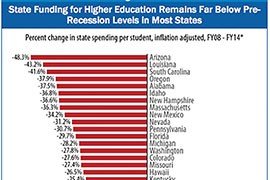Cronkite News has moved to a new home at cronkitenews.azpbs.org. Use this site to search archives from 2011 to May 2015. You can search the new site for current stories.
Report: Arizona had steepest higher-ed cuts, highest tuition increases
WASHINGTON – Arizona had the nation’s steepest per-student cuts in state aid to higher education and the highest rates of tuition increase from pre-recession funding levels until today, according to a new report.
The report Thursday by the Center on Budget and Policy Priorities said the per-student rate of support for higher education in Arizona fell 48.3 percent from 2008 to 2014 while tuition rose 80.6 percent. Both numbers were adjusted for inflation and both were tops among states.
But Arizona was not alone. The report said that while most states – including Arizona – had started to restore the funding that was cut in the depths of the recession, the increases were slow in coming: 48 states are still spending less per student, when adjusted for inflation, than they did before the recession hit.
“These cuts were severe and widespread,” Michael Mitchell, a policy analyst who co-authored the report, said in a conference call.
“This is the result of policy choice and was not pre-determined” by the economy, Mitchell said. “Over the past 25 years costs have shifted more from states to students.”
Eileen Klein, president of the Arizona Board of Regents, agreed that there has been a funding shift, but said it can be an opportunity for the state’s universities.
“The state is no longer the majority shareholder,” Klein said. “We see this as an opportunity to re-engineer our offering and be more competitive.”
She said a major factor behind the rising tuition costs has been the steady growth in the number of students in Arizona’s universities.
“The landscape is different than it was before the recession,” Klein said. “We have taken in 23,000 more students. That’s the equivalent of adding a new NAU (Northern Arizona University).”
Rising enrollment was one reason the report cited for college budget woes. A surge in the 18- to 24-year-old population combined with a lack of jobs during the recession to push more students into colleges and universities. Full-time public higher education enrollment rose by about 1 million students nationwide from 2008 to 2014, the report said.
Arizona fared slightly better among states when the report looked at the dollar change in state support and not just the rate of funding cuts. The report said Arizona cut $3,082 in per-student state support between 2008 and 2014, the 10th-highest inflation-adjusted cut in the nation but still well above the national average cut of $2,026.
On tuition increases, however, Arizona was first for both rate and dollar increases: The 80.6 percent tuition increase from 2008 to 2014 translated to $4,493, compared to national average increases of 28 percent and $1,936, respectively.
Students were not the only ones affected by the budget cuts. The report said more than 2,100 Arizona university jobs have been cut and 182 departments, colleges, schools and programs have been either consolidated or eliminated since the start of the recession.
There has been slight improvement as the nation climbs out of recession. Over the last year, state spending rose an average of $443 per student across the country. Arizona’s increase of $143 per student was 37th among states.
Klein said the future will require establishing new programs rather than trying to restore the ones previously lost. She wants to focus on helping the state’s 144,000 university students discover their majors earlier, so they can avoid wasting money on unnecessary classes.
Mitchell said the issue cannot be ignored.
“By the year 2020, 65 percent of jobs will require some college education and the country is projected to fall 5 million workers short of that demand,” he said.








